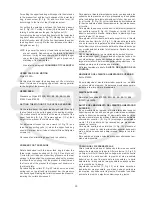
The presser foot lift is limited with the upper stop collar (D,
Fig. 23) on the right presser bar. When the needle is in its
lowest position and the presser foot is lifted with the presser
foot lifter lever, the needle holder should not contact the
presser foot. Besides this, the lifted presser foot should
not contact the right upper spreader or upper looper moving
upwards. Set the stop collar (D) accordingly.
Make sure that both presser bars move up and down freely
without binding.
Now turn in T-screw (B, Fig. 22) until the necessary presser
foot pressure for proper feeding is exerted (determine by
sewing tests). Secure this setting with the knurled nut (A)
which simultaneously fastens the upper arm cover.
Remount the face cover and the finger guard.
CHANGING STITCH LENGTH
The length of the stitch can be adjusted by raising or
lowering stud (A, Fig. 24) in the segment slot of feed rocker
(C) located at the rear of machine below the cloth plate.
Lowering stud (A) will lengthen the stitch, raising the stud
will shorten the stitch. After loosening nut (B), stud (A) can
be moved accordingly. When the desired stitch length is
obtained, retighten nut (B).
NOTE: Any change in stitch length necessitates a corres-
ponding change in the rear needle guard setting
and matching of the upper feed dog travel.
Refer to paragraphs
SETTING THE REAR
NEEDLE GUARD
and
SETTING THE UPPER
FEED DOG
.
La elevación del pie prensatelas se limita con el anillo de
ajuste (D, Fig. 23) en la parte superior de la barra derecha
del pie prensa tela. Cuando la aguja está en su posición
más baja y el pie prensa tela levantado, el porta aguja no
debe tocar el pie prensa tela. Además, cuando el pie
prensatelas está levantado no debería contactar el looper y
el spreader superiores en su movimiento hacia arriba.
Asegure el anillo de ajuste (D) adecuadamente.
Asegúrese que ambas barras del pie prensa tela se muevan
libremente hacia arriba y abajo.
Ahora apriete el tornillo (B, Fig. 22) hasta que haya suficien-
te presión al pie prensatela para el transporte de la tela (com-
pruebe con ensayos de costura). Asegure esta posición con
la tuerca (A) , con la cual se fija simultáneamente la tapa
superior en el brazo de la máquina. Coloque otra vez la tapa
lateral en el brazo y el protector de los dedos.
CAMBIO DEL LARGO DE LA PUNTADA
El largo de la puntada se ajusta subiendo o bajando el perno
(A, Fig. 24) en la ranura del marco del transportador (C) ubi-
cado en la parte posterior de la máquina debajo de la tapa
de la máquina. Bajando el perno (A) alarga la puntada, su-
biendo el perno acorta la puntada. Después de aflojar la tuer-
ca (B) se puede mover el perno (A) adecuadamente. Apriete
la tuerca (B) otra vez después de haber fijado el largo de la
puntada.
NOTA: Cada cambio en el largo de la puntada, necesita
que se ajuste el guarda aguja trasero y el movimien-
to del diente alimentador superior.
Refiérase a los parágrafos
AJUSTE DEL GUARDA
AGUJAS TRASERO
y
AJUSTE DEL DIENTE
ALIMENTADOR SUPERIOR
.
30
Summary of Contents for 81500B2
Page 8: ...8 INSTALLATION INSTALACION...
Page 10: ...10...
Page 21: ...21...
Page 23: ...23 Fig 10 Fig 11 Fig 11 A Fig 11 B Fig 11 C Fig 12...
Page 25: ...25...
Page 28: ...28...
Page 33: ...33 VIEWS AND DESCRIPTION OF PARTS VISTAS Y DESCRIPCIONES DE LAS PARTES Y PIEZAS...
Page 34: ...34...
Page 36: ...36...
Page 38: ...38...
Page 40: ...40...
Page 42: ...42...
Page 44: ...44...
Page 46: ...46...
Page 48: ...48...
Page 50: ...50...
Page 52: ...52...
Page 54: ...54...
Page 56: ...56...
Page 58: ...58...
Page 60: ...60...
Page 62: ...62...
Page 64: ...64...
Page 68: ......
















































